How gangs of “Knights of the Cross” captured Constantinople
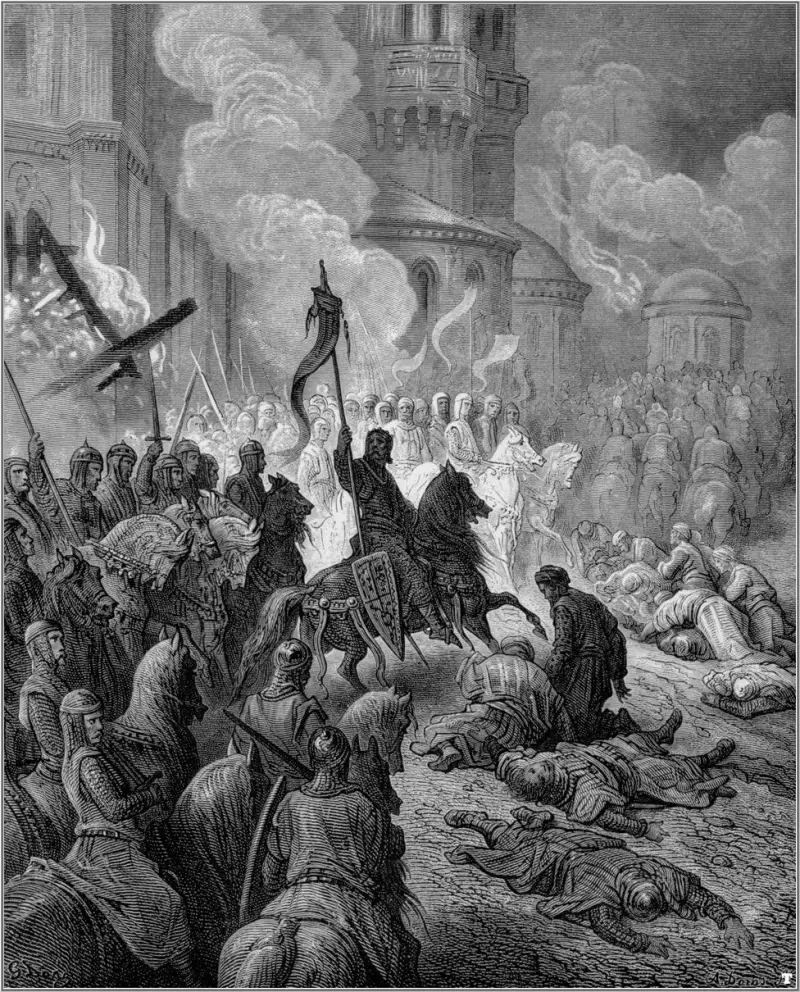
Entry of the Crusaders into Constantinople on April 13, 1204 by Gustave Doré
Crusades
In the conditions of the severe crisis that during this period gripped the then West - Western European civilization, which initially stood on robbery and parasitism, Papal Rome found a way out - the Crusades. The name of Christ illuminated the military-colonial movement to the East - to the lands of the Slavs and the Muslim world.
Various circles of the then Western European feudal society were interested in the crusades. The papal throne “with iron and blood” propagated its religion, increasing the number of “flock” (“flock”). Spiritual feudal lords needed new lands and slaves. Rome also solved the problem of conquering neighboring civilizations - the Rus-Slavs, Eastern Christians and Muslims. The papacy could raise Europe to a “holy war” against Muslims, pagans and eastern schismatics (schismatics) - the Orthodox.
Feudal lords and knights needed new lands to conquer, new serfs to exploit, mining and gold. Western Europe was already divided, an overabundance of knights led to severe strife, wars, it was necessary to channel energy into a new “living space”. This group included various declassed elements, mercenaries, adventurers who dreamed of a big jackpot.
The predatory eyes of the owners of the trading cities that were rising at that time in Europe, especially in Italy, were turned to the rich East. They wanted to seize trade routes in the eastern Mediterranean and gain access to the markets of the fabulous East - Persia, India and China. There were also interests of slave traders here.
Rumors about a fabulously rich and “free” East also circulated among the peasantry and urban poor. The peasants dreamed of moving to lands free from serfdom. About the heavenly “Promised Land”, free from feudal lords, without wars and famine.
Therefore, from the end of the 11th century, the Roman throne zealously began information preparation (sermon-propaganda) for the crusades. The organization of crusades became one of the methods of influence of popes on European monarchs. Rome received a pretext for interfering in the internal affairs of European countries. The papacy also received a new source of income and a tool for enhancing prestige.
At the same time, a long struggle for dominance in the Mediterranean began between the Byzantine Empire, Venice, the Kingdom of Sicily (the southern Italian state of the Normans), France, England and the Holy Roman Empire. The states of the West and the East were part of a variety of alliances. At the same time, large Western feudal lords are mastering the cunning methods of Eastern and Byzantine politics.
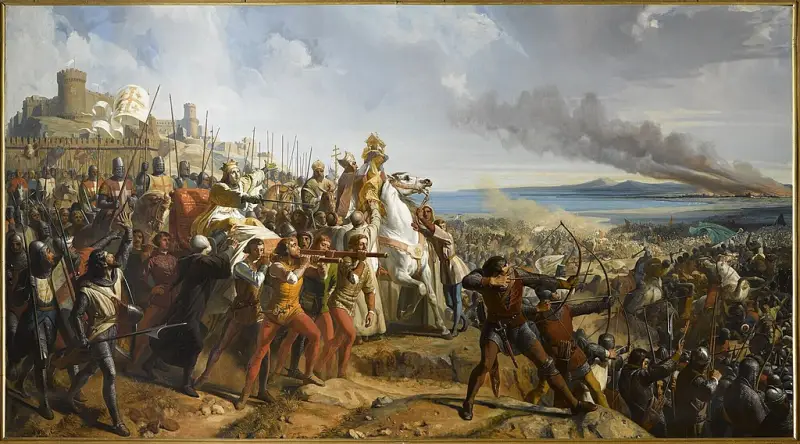
Painting by the French artist Lariviere depicting the Battle of Montgisard (1177) between the forces of the Kingdom of Jerusalem and the Ayyubid army led by Salah ad-Din, in which the Crusaders were victorious
“God wants it that way!”
The Crusades were preceded by great political and informational preparation. Byzantium, which in the last decades of the 11th century was actively pressed by the Seljuks, Pechenegs and South Italian Normans, more than once asked for help from the princes and kings of the West. The Roman throne tried to use the problems of the Second Rome to subordinate it to its influence and make the Eastern Church dependent.
Pope Gregory VII (1073–1085) sought to impose an ecclesiastical union on Byzantium. In 1074, he plots to send a knightly army from the West to Byzantium, hypocritically setting it the task of “rescuing” the Greek Church, which is threatened by infidels, from trouble. Gregory was the first to call for a crusade against the Seljuks, but to no avail. The Pope was distracted by affairs in the West - mainly the fight with the Holy Roman Emperor Henry IV. The Papal throne claimed complete dominance in Europe.
Gregory's plans were supported and developed by the second of his successors, Urban II (1088–1099). The pretext was a call for help against the Muslims by the Byzantine Emperor Alexios Komnenos. At the Council of Clermont, held in November 1095, the pope called on Christians to wrest the Holy Land from the hands of the “infidels” by force:
Let those people who are accustomed to fight against their fellow believers - Christians, come out against the infidels in battle, which should yield trophies in abundance...
That land flows with milk and honey. May those who used to be robbers and fight against their brothers and fellow tribesmen now become warriors. He who is sorrowful here will become rich there.”
The pope's speech was interrupted by cries from the audience: Dieu le veut! (“God wants it that way”). The listeners, inspired by such a speech, vowed to free the Holy Sepulcher from the “infidels.” Obviously, the majority were inspired by the “abundance of trophies” and the fact that “that land flows with milk and honey.”
Those who wished to go on a hike sewed a red cross onto their clothes. This is where the name “crusaders” came from.
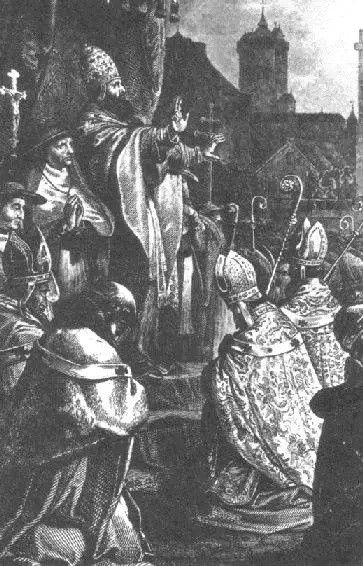
Pope Urban II blesses the Crusade at the Council of Clermont
Successes and failures of the crusaders
Tens of thousands of crusaders moved to the East - the first campaign of 1096–1099. Taking advantage of the fragmentation of the Muslim East, the first crusaders captured a number of territories on the eastern coast of the Mediterranean Sea. At the end of the XNUMXth - beginning of the XNUMXth century, states were founded: the Kingdom of Jerusalem, the counties of Tripoli and Edessa, and the Principality of Antioch. However, then the unification of the Muslim principalities and their counter-offensive began.
This caused new campaigns of the crusaders. In response to the capture of Edessa by the “infidels” (1144), a second crusade followed (1147–1149), but it ended in complete failure. Edessa was lost forever. The 4 decades that followed were a time of loss of positions for Christians and strengthening of Muslims.
The talented ruler and commander Saladin (actually Salah ad-din Yusuf ibn Ayyub) subjugated Damascus, all of Muslim Syria, most of Mesopotamia and took the title of sultan. He led the offensive against the crusaders, who were weakened by internal contradictions. After the death of the reasonable King Baldwin, during which some balance was established between Jerusalem and Damascus (this plot is shown in Ridley Scott’s magnificent historical adventure film “Kingdom of Heaven”), Saladin launched a successful offensive.
In 1187, he defeated the crusaders at Hattin, capturing King Guy of Lusignan and the entire command of the crusaders. Saladin then captured Acre, Beirut, Sidon, Caesarea, Ascalon and other cities. Besieged and occupied Jerusalem. Only Tire, Tripoli and Antioch remained in the power of the crusaders.
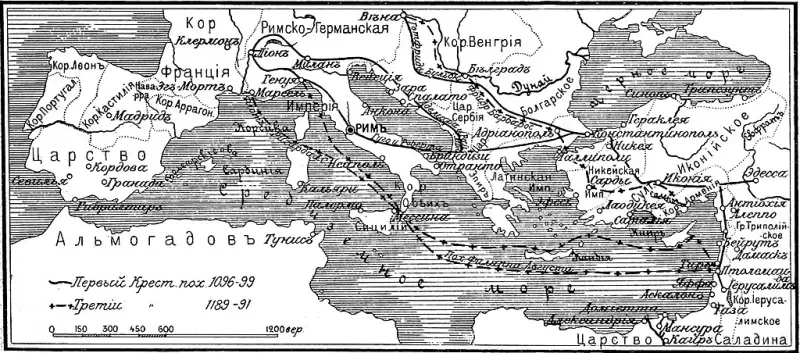
The Crusades of 1096–1099 and 1189–1191 (drawing from the article “Crusades” “Sytin’s Military Encyclopedia”; 1913)
Saladin's successes sparked a new movement in Europe, leading to the Third Great Crusade (1189–1192). Its results were minimal for the crusaders. Their leaders quarreled more than fought with the Muslims.
Personal ambitions, the desire to seize key positions on the Mediterranean Sea, which led to control of the most important communications of the then trade, pitted large feudal lords against each other. This led to the emergence of a wide variety of political combinations and alliances. Moreover, quite often religious views did not play a special role.
Thus, during the second crusade, the sovereign of Sicily Roger II, whose power claimed dominance in the Mediterranean, and he himself called himself “defender of Christianity,” entered into an alliance with the Muslim Sultan of Egypt and attacked Christian Byzantium. And another leader of the crusaders, the German king Conrad III, was in alliance with Constantinople.
During the Third Crusade, an interesting political plot also emerged.
The Greeks entered into an alliance with Saladin against the Crusaders. The French king Philip II intrigued in every possible way against the English king Richard the Lionheart. During a stop in Sicily, this enmity became open. Richard tried to conquer the island, and Philip opposed him.
Subsequently, the cunning French monarch used the failures of his “ally” to attack his possessions in France, and agreed with the Holy Roman Emperor Henry VI on a joint fight against Richard. As a result, Richard spent two years in captivity in Germany while returning home from Palestine.
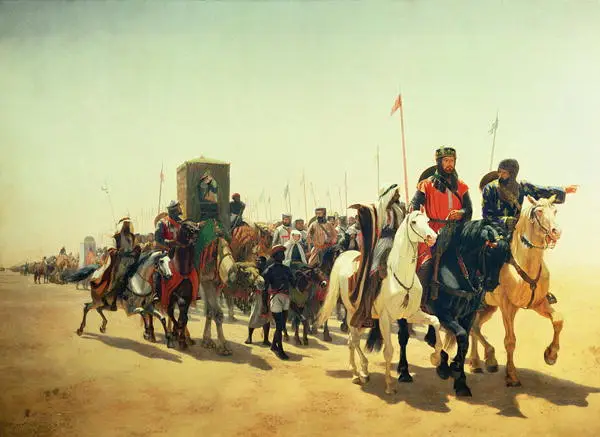
King Richard the Lionheart on his way to Jerusalem. James William Glass
Weak link
In this case, Western predators quickly discovered the “weak link” of the East - the decrepit and degraded Byzantine Empire. Moreover, with very rich cities, strategic ports that controlled important trade routes.
For the most part, the poor and ragged crusaders who walked through Byzantium to the Promised Land looked greedily at the riches of the Second Rome. Byzantium seemed to them, and not without reason, an easy prey. To reach the Saracens it was necessary to go through mountains, deserts and seas, to die from thirst, hunger, storms, and enemy arrows. The enemies were toothy.
Hordes of crusaders, during all three campaigns, plundered the inhabitants of the Byzantine Empire and looked greedily at its cities, the capital, which had not yet lost the luster of the world. Compared to the wretched world and towns of Western Europe, it was a developed urban civilization that preserved part of the heritage of ancient civilization, its cultural riches.
The Greeks understood that their world was under threat not only from Muslims, but also from Catholics. Therefore, Byzantine diplomats used traditional diplomacy: divide and conquer. They tried to use dangerous allies for their own purposes. The first detachments of the crusaders were used to fight the Seljuks.
In the 12th century, Second Rome often took the side of Muslims against the Crusaders. Thus, during the second crusade, Basileus Manuel Comnenus, despite the official alliance with the German king Conrad, entered into an agreement with the Seljuk Iconian Sultanate when the German knights were already fighting with him.
During the Third Crusade, the King of Germany and Holy Roman Emperor Frederick I Barbarossa (1155–1190) negotiated with the Greeks for free passage through Byzantium. However, the crusaders began military operations against the Byzantines, and the German king was thinking about the siege of Constantinople. The Greek basileus Isaac II Angel signed an alliance treaty with Sultan Saladin.
However, the Roman emperor even earlier began contacts with the Iconian Sultanate, hostile to Byzantium and Saladin.
Thus, both Christian emperors found themselves in alliance with the Muslims in 1189. Frederick also tried to set Serbia and Bulgaria against Byzantium.
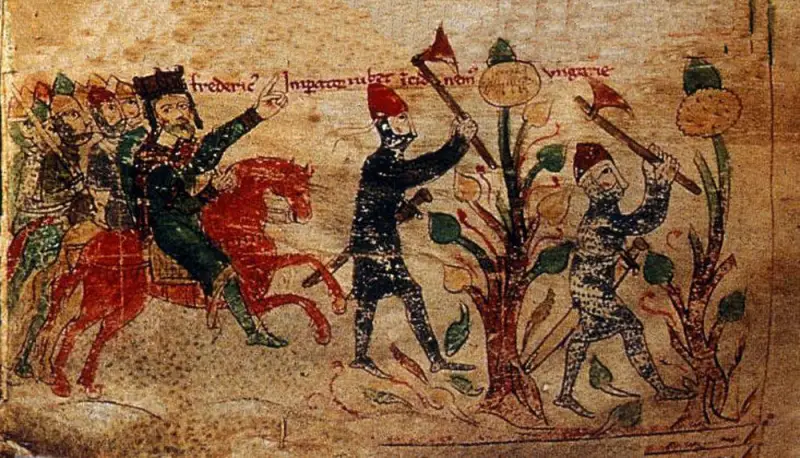
Frederick Barbarossa on the Crusade. Miniature of the manuscript of Peter of Eboli, late 12th century.
Frederick Barbarossa considered himself the heir of the Roman emperors, the legitimate sovereign not only of the West (including Italy), but also of the East. He called the Byzantine Empire the “Greek Kingdom” as his rebellious vassal.
For their part, the Byzantine basileus considered themselves the true heirs of Ancient Rome. The Greeks helped the Italian enemies of the German emperor with money. As a result, Barbarossa lost the fight for Italy.
Only deft Byzantine diplomacy prevented Frederick from attacking Constantinople, although the crusaders had already captured Adrianople. The Greeks transported the knights to Asia Minor, and they went south. During the campaign, the emperor drowned in the Saleph River, and the expedition fell apart.
At the same time, at the end of his reign, Frederick managed to win a great diplomatic victory, creating a new threat to Byzantium. He married his son, the future Emperor Henry VI (1191–1197), to the heir to the throne of the Kingdom of Sicily, Constance, and acquired Sicily and Southern Italy for his dynasty. A wealthy kingdom that previously laid claim to power in the region. Henry drowned all conspiracies and rebellions in blood, killed subjects who did not want to obey him, and plundered the country.
The Sicilian kingdom was then a kind of bridge between the West and the East, like Byzantium. Many Greeks, Jews and Muslims lived there, closely connected with eastern trade. Sicily became the base for a new crusade that Henry was preparing. A huge fleet was assembled, which, apparently, the Roman emperor wanted to send to storm Constantinople.
At the end of the summer of 1197, he arrived in Messina to personally be present at the start of the crusade. But all these extensive plans were suddenly stopped. Henry, who was only 32 years old, suddenly fell ill and died. Perhaps he was poisoned.
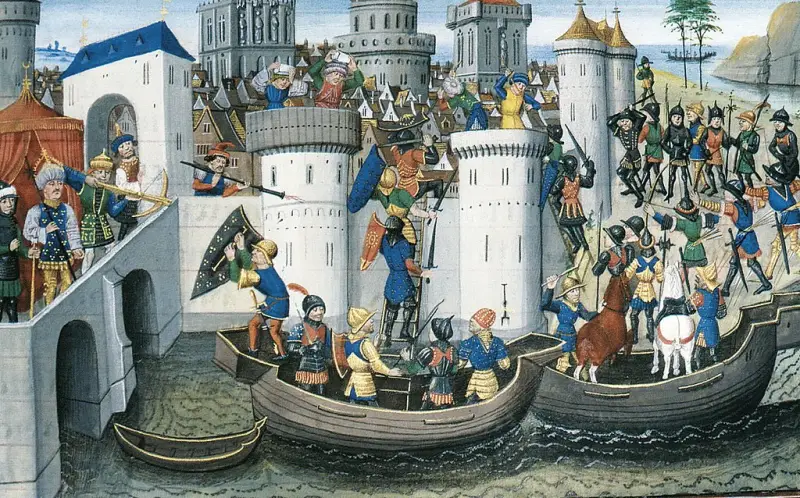
Siege of Constantinople by the Crusaders (1204). Miniature from the Chronicle of Emperors by David Ober. 1470s
To be continued ...
Information